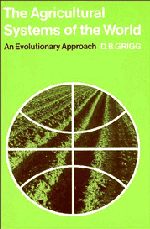Book contents
- Frontmatter
- Contents
- Acknowledgements
- 1 Introduction
- PART ONE
- PART TWO
- 5 Shifting agriculture
- 6 Wet-rice cultivation in Asia
- 7 Pastoral nomadism
- 8 Mediterranean agriculture
- 9 Mixed farming in western Europe and North America
- 10 Dairying
- 11 Plantations
- 12 Ranching
- 13 Large-scale grain production
- 14 Conclusions
- Appendix: Regions of plant domestication
- Notes
- Bibliography
- Index
6 - Wet-rice cultivation in Asia
Published online by Cambridge University Press: 10 March 2010
- Frontmatter
- Contents
- Acknowledgements
- 1 Introduction
- PART ONE
- PART TWO
- 5 Shifting agriculture
- 6 Wet-rice cultivation in Asia
- 7 Pastoral nomadism
- 8 Mediterranean agriculture
- 9 Mixed farming in western Europe and North America
- 10 Dairying
- 11 Plantations
- 12 Ranching
- 13 Large-scale grain production
- 14 Conclusions
- Appendix: Regions of plant domestication
- Notes
- Bibliography
- Index
Summary
Wet-rice cultivation is perhaps the most distinctive of the types of agriculture discussed in this book, and certainly one of the most important, for it supports a majority of the rural population of the Far East. It is the dominant mode of farming in China as far north as the Hsin Ho; in South Korea; in most of Japan; in Taiwan; in the Tonkin delta and the Annamite coastlands in North Vietnam; in the Mekong delta and around the Tonlé Sap; in the Central Plain of Thailand; the Irrawaddy delta; the Ganges–Brahmaputra delta, the lower Ganges plain, the deltas of the eastern coast of India, and in Kerala; in Sri Lanka (Ceylon) it is important in both the Dry and Wet Zones. In the islands of South East Asia wetrice cultivation is less widespread than on the mainland, but it is found in Java and the central plain of Luzon (Fig. 12).
Although wet-rice cultivation supports much of the rural population of the Far East, it occupies but a small part of the total area. Rice is tolerant of a wide range of soils. It requires high temperatures in the growing season, with mean monthly temperatures of at least 20C for three or four months, but this does not greatly restrict its range, and it is grown as far north as Korea and Hokkaido. Nor are the minimum moisture requirements excessive, although ideally it requires at least 1778 mm during the growing season, which is, throughout the area under discussion, the period of the summer monsoon.
- Type
- Chapter
- Information
- The Agricultural Systems of the WorldAn Evolutionary Approach, pp. 75 - 111Publisher: Cambridge University PressPrint publication year: 1974
- 1
- Cited by



